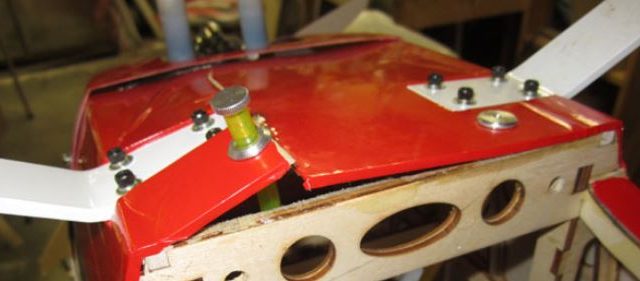How a 2 Stroke Carburetor Works, Fuel Pump & Metering
Balancing a propeller
How to repair RC landing gear
How do proper foam rc plane repairs
Basic airbrush 101 for Foamies
How to restore EPO models
How to perform the slow roll
8 Great tips
How to install a Removable Engine Box Firewall
Trimming your plane to fly smoothly
Easy engine testing
Airplane storage tip
Keeping your wheels in place
Quick linkage
Here’s a quick way to make perfect control linkages every time. First, switch on your receiver and transmitter so that all of your servos are centered. Next, use a Popsicle stick and a couple of clothespins to hold your control surface straight in its neutral position. (For ailerons, clip the stick spanwise and attach the clothespins so that one clamps the aileron and the other clamps the wing’s trailing edge.) You can now install your pushrods and install the clevises and connectors. Adjust the clevises so that they connect to the control horns, and tighten in place. Remove the sticks and clamps and the job is done.
Think small
When you are custom mixing paints, such as when you are trying to match a camouflage color, think in small amounts. By mixing up small batches using glass jars and measuring cups, you can fine-tune your mixtures without wasting too much paint. If you get it wrong, you throw out an ounce at a time, not pints or quarts. When you do get the ratios correct, write them down and then you can multiply the ratios to mix larger quantities.
Workbench catch-all
A simple way to stop losing screws and small hardware items is to use a handy cup or storage container to collect the little bits while you are working on your model airplane. This makes them easy to find after the job is done, prevents them from rolling off the workbench, and prevents hangar rash by keeping your bench clear of those hard bits that dent wing surfaces and other parts of the model. Get these inexpensive and disposable containers at the grocery store.
Paint drips
An easy way to avoid messy paint drips around the workshop is to take a rubber band and slip it over the paint can as shown. You can now dip in the brush and wipe the excess paint off the bristles by pulling them over the rubber band, which is stretched over the can’s opening. This tip is great for all brush-on paints, including dope and epoxy paints.
Easy Epoxy Remover
Sometimes there is a real need to separate two parts that are epoxied together such as after a crash when you need to glue them back together. One of the easiest ways to separate the epoxy from the wood is to use a heat gun like the one used for shrink covering. Just head up the epoxy with the gun and then loosen it by using a scribe or small screwdriver to remove it from the wood. If you have heat-shrink covering on the other side of the wood, use a wet cloth sponge up against it to keep that cool while heating up the other side.
Cutting corners on patch jobs
When using MonoKote or UltraCote to repair rips and punctures in model coverings, start by cutting a round or oval patch repair piece. This will help to keep the corners from lifting off later on. Leave one corner square to help peel off the backing with a razor blade or hobby knife, then round it before applying the patch to the repairs.
Handy Hinge Glue Spreader
Many of today’s 3D foamie airplanes utilize contact adhesive as a hinge material. Spreading the glue can be a messy job. A single-edged razor blade makes an excellent spreading tool but sometimes it can be difficult to use in tight places. By attaching a wooden clothespin to the razor blade, it’s easier to get into tight spots and create a nice clean hinge line.
Saved By the Bowl
When you’re working on a project with a lot of small screws, nuts, etc., do so over a small 4- or 8-inch-diameter magnetic bowl (available in car parts stores or Harbor Freight). Ifyou accidentally drop these small parts, they’ll fall right into the bowl and not on the floor, where they are never to be seen again.














